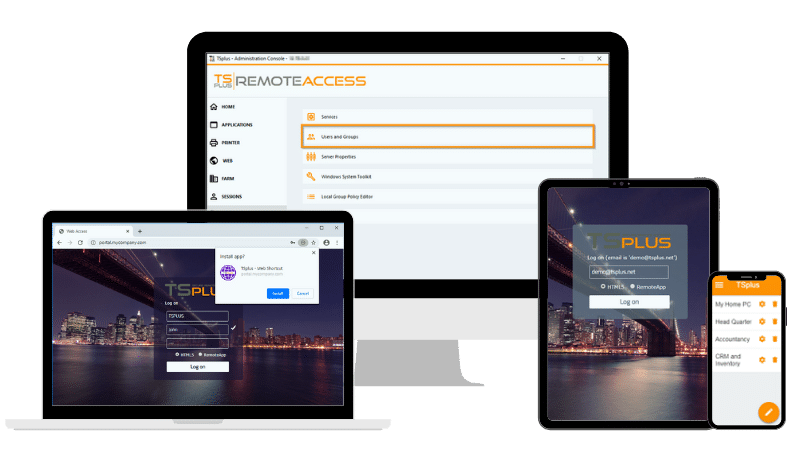)
)
Why Is There a Confusion?
Choosing the right remote solution can be tricky. Remote working and the associated software that enables it can be quite confusing. Indeed, the differences between them are not always clear-cut and there is a wide range of available tools, so it is not always clear which products will work best in a given scenario. This guide breaks down the key differences between remote access, remote desktop, remote work and remote support software, including their definitions, use cases and pros and cons, so you can find the best fit for your needs.
Understanding the Core Concepts
Remote software solutions are crucial for productivity and security, using a variety of connection modes including RDP, VDI and others. However, these tools are often confused with each other, leading to costly mistakes in software selection.
Remote access, remote desktop Remote support and remote work can be described as enabling workers to do similar things. Yet when looking closer, it becomes clear that their purpose, use and structures differ, though those differences are not often well communicated by many software developers and media vendors. Application access, session and screen sharing, and remote working are used in different contexts by different people.
What is Remote Access Software?
Remote access software allows multiple users to connect to a centralized environment, such as a server hosting business-critical applications or desktops. It enables secure, centralized access to work resources without requiring physical presence.
Key Features:
- Multi-User Access:
Supports multiple users accessing the same server simultaneously, each in their own secure session.
Centralized IT Control:
IT administrators can easily manage user permissions, application access and data security from a central point.
Flexible Deployment:
Can be deployed on local servers or through cloud infrastructure, offering flexibility for different business models.
Cost Efficiency:
Reduces the need for high-end hardware at individual workstations, cutting down overall IT costs.
- Seamless Application Delivery:
Enables fast, secure access to core business applications without complex installations on local machines.
Common Use Cases:
Accessing business applications like ERP, CRM or accounting systems
- Shared virtual work environments
- Reducing local machine maintenance needs
How It Works:
Each user opens a personal session on a remote server that hosts company software and resources. The IT team defines access rights for users, ensuring only authorised personnel access sensitive data.
What is Remote Desktop Software?
Remote desktop software enables a user to remotely control a specific computer, over a network connection, replicating the experience of sitting in front of it.
Key Features:
- Direct Full Desktop Access:
Users gain complete control over a specific remote computer, with access to all apps and files.
- Cross-Device Compatibility:
Works across various devices, including PCs, tablets and smartphones, ensuring easy access from anywhere.
High Performance for One-to-One Connections:
Optimised for stable and responsive connections, especially when network conditions are favourable.
- Remote Administration & Maintenance:
Ideal for system administrators managing servers or performing updates on remote systems.
- Secure Encryption & Authentication:
Typically supports robust security protocols such as multi-factor authentication and strong encryption.
Common Remote Desktop Use Cases:
- IT administrators managing servers from remote locations
Users accessing their office desktop while travelling
- Troubleshooting computers without physical presence
How It Works:
Remote desktop provides a secure session established between the user’s device and the remote computer, allowing the user to interact with the system as though they were physically present.
What is Remote Support Software?
Remote support software is intended for IT teams and support technicians to provide assistance, perform troubleshooting or take control of a user’s device.
Key Features:
- Real-Time Screen Sharing:
Enables IT support agents to see and control the user’s screen instantly to diagnose and solve issues.
One-to-One Secure Sessions:
Designed for direct assistance, allowing temporary, secure connections between the technician and the user.
- Integrated Communication Tools:
Often includes chat, file transfer and voice features for better collaboration during support sessions.
Session Logging & Reporting
Many solutions allow recording of sessions for training, compliance and auditing purposes.
Quick Deployment & Use:
Requires minimal setup, making it ideal for urgent IT troubleshooting or helping remote employees in real time.
Common Use Cases:
Technical support for end-users
Remote maintenance and diagnostics
Software installation and configuration
How It Works:
A support agent connects to the user’s device via a secure tunnel, gaining temporary control to diagnose issues, install updates or offer live training.
Read more here to explore why remote support tools are becoming essential for small businesses and corporations.
What is Remote Work Software?
Remote work software is designed for employees to securely access their own assigned workstation from any location, providing an uninterrupted office-like experience. In effect, it is a result of specific configuration choices and permissions applied to a specific user or group (set of users) within the above software types.
Key Features:
- Dedicated Workstation Access:
Connects users exclusively to their assigned office computers, providing continuity between remote and on-site work.
- Persistent Work Environment:
Users retain access to their personalised desktop, including files, apps and settings, no matter where they connect from.
- Simple Remote Onboarding:
Allows businesses to easily onboard remote employees by assigning them remote access to their workstation.
Robust Security & Compliance:
Ensures compliance with data protection laws by limiting access to specific systems and using strong encryption.
Ideal for Hybrid Work Models:
Perfect for organisations balancing in-office and remote work schedules, ensuring smooth transitions between environments.
Common Use Cases:
Hybrid work scenarios
Healthcare professionals needing access to specialised software
Employees requiring high security or regulatory compliance
How It Works:
The software creates a secure link between the employee’s remote device and their assigned office workstation, allowing them to work exactly as they would on-premises.
Differences at a Glance
Here is a clear comparison of the three types of software and their remote work possibilities:
| Feature | Remote Access | Remote Desktop | Remote Support | Remote Work |
|---|---|---|---|---|
| Connection Type | Many-to-one | One-to-one | One-to-one | One-to-one |
| Main Purpose | Shared app/desktop access | Full desktop control | Troubleshooting/Support | Access personal workstation |
| Typical User | Office employees | IT admins, remote workers | IT Support Agents | Assigned employees |
| Primary Benefit | Centralized IT management | Full PC control remotely | Quick issue resolution | Seamless office-to-home switch |
| Typical Examples | TSplus Remote Access, Citrix | TSplus Remote Access, Microsoft RDP, Chrome Remote Desktop | TSplus Remote Support, TeamViewer | TSplus Remote Access or Remote Support, SplashTop |
How to Choose the Right Solution
Choosing the right remote solution depends on several factors, including your organisation’s size, IT infrastructure, security requirements and long-term goals. Each tool serves a distinct purpose, and understanding your priorities is crucial for selecting the most effective option.
Questions to Consider Before Choosing:
1. What is your main objective?
Are you aiming to:
- improve productivity?
- streamline IT management?
- provide remote support?
- or enable hybrid work?
2. How many users will need remote access at the same time?
Some solutions are designed for large-scale multi-user environments, while others are best for individual connections.
3. Do your users need access to individual workstations or centralised resources?
Solutions differ between shared environments and dedicated personal workstations.
4. What level of security and compliance do you require?
Consider industry regulations such as HIPAA, GDPR or PCI-DSS, then choose tools with adequate encryption and access controls.
5. Do you prefer cloud-based deployment, on-premises infrastructure or a hybrid approach?
This affects scalability, control and ongoing maintenance.
Organizations should also review guidelines from the U.S. National Institute of Standards and Technology (NIST) on Telework and remote access security or their local equivalent official source to ensure compliance with cybersecurity standards.
Recommended Solutions Based on Business Needs:
For Centralized Access to Shared Resources:
Choose Remote Access solutions by TSplus for full application publication capacity and freedom. Remote access is ideal for companies that need centralised control over business applications and desktops at an affordable price.
For Full Control Over a Specific Desktop Remotely:
→ Opt for Remote Access as an effective and scalable alternative to the likes of Microsoft Remote Desktop or Chrome Remote Desktop. This is suited for remote administrators or users needing full control over one device.
For Seamless Workstation Access Across Locations:
Use TSplus Remote Access with customised configuration as you might SplashTop but for less. It is perfect for employees who need secure, continuous access to their personal office computers from home or other locations.
For IT Support and Troubleshooting:
→ Select solutions such as TSplus Remote Support as an alternative to TeamViewer, designed specifically for IT teams to offer fast, effective remote assistance. Easily hacked into remote training software, Remote Support enables multi-device control including PCs, macOS and Android.
No matter which option you choose, it is essential to align the solution with your company’s operational needs, budget and IT strategy to maximize efficiency and security.
Real-World Examples & Use Cases
TSplus Remote Access for Franchise Operations
SpaSalon USA, a leading spa and beauty chain, utilizes TSplus Remote Access to manage its scheduling, inventory and billing software centrally. Employees from multiple locations can access these applications without installing software locally, drastically reducing maintenance costs.
Remote Work Software in Healthcare
Hospitals and clinics often deploy remote work solutions to allow secure workstation access by medical professionals. This enables them to review patient records, manage schedules and access pharmacy systems securely, even during emergencies or after hours.
Remote Support Software in Small Businesses
Many SMBs use TSplus Remote Support to provide remote IT assistance without relying on external servers. This solution allows secure remote troubleshooting and software updates, preserving data confidentiality and reducing downtime.
Conclusion
In conclusion, understanding the differences between remote access, remote desktop, remote work and remote support software is essential for selecting the right tool for your organization. Each TSplus solution offers unique benefits tailored to specific needs, whether for productivity, IT support or secure remote work. By carefully evaluating your business goals and technical requirements, you can ensure efficient, secure and seamless remote connectivity for your team.

TSplus Remote Access Free Trial
Ultimate Citrix/RDS alternative for desktop/app access. Secure, cost-effective, on-premises/cloud














)
)
)